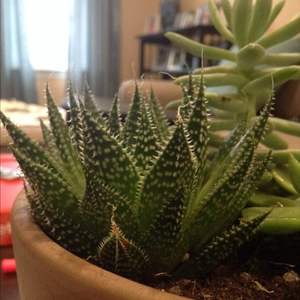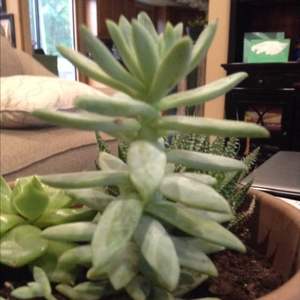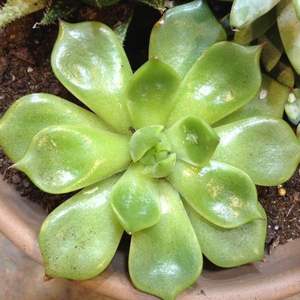成长记
2B_BotanicalFie
2018年06月24日

I now added "Sulcorebutia Rauschii “ Violacidermis”" in my "garden"


0
0
成长记
2B_BotanicalFie
2018年06月24日

I now added "Saxifraga Stolinifera Tricolor (cutting 2)" in my "garden"


0
0
文章
Miss Chen
2018年06月24日


2.Assemble Materials and Plants
A trip to a full-service garden center will likely provide you with all the materials you need. Or you can order materials (except for the plants) from online retailers. The things you'll need include:
A container with drainage holes (shallow containers are best)
Succulent plants selected to fill container
Plastic window screening (or a piece of landscape fabric or a coffee filter)
Cactus or succulent potting soil
Stones, gravel, sea glass or marbles

3.Cover Drainage Holes
Cut a piece of plastic window screening big enough to cover your pot's drainage holes. This will keep your potting soil in while letting the excess water drain out of the container.
If you don't have window screening, you can use a piece of landscape fabric cut to size or a coffee filter to cover the holes. Although they are a little more expensive, you can also use commercial pot screens, available at garden centers and online retailers.

4.Add Soil
Cover the bottom of the container with enough succulent mix potting soil so that when the plants are placed, the soil line on their stems will remain about 1/2 inch below the rim of the container. This will mark the final soil level, and will make it easier to water without overflowing the sides of the container.

5.Test-Fit the Plants
First, place your plants, still in their nursery pots, into the container to get a general idea of the container design. Move the plants around until you are satisfied with the arrangement. Classic container garden design practice is to make sure that any container garden has a central "thriller" specimen, a group of "filler" plants and others that are "spillers" that flow over the edges of a container. But this arrangement is entirely up to you. Wonderful containers gardens often result from breaking traditional design rules.
0
0
文章
Miss Chen
2018年06月24日

Anyone can learn how to container garden. Seriously. I used to be a confirmed slayer of all plants. My thumb was not green, it was a destroyer of green. However, over time I learned how to keep plants in containers alive, at least for the most part. I still do kill plants--on a fairly regular basis--but have come to the conclusion that all gardeners do. It's just part of the deal. All you can hope for is that the pleasure of gardening will outweigh the inevitable pain of losing plants. But the good news is that there can be huge joy in container gardening and you can learn how to do it.

1.Learn Basics of Succulent Planters
Growing a succulent container garden is easy and immensely satisfying. By nature, succulent plants are tenacious, vigorous plants with low-moisture needs—they have evolved to thrive in some of the world's harshest conditions, so they are generally very easy to care for. In fact, the biggest challenge to most succulent plants is avoiding excessive nurturing—they don't do very well if they are overwatered and overfed. This makes them perfect for the gardener who doesn't have a lot of time to spend on tending plants.
Design Considerations
Although most succulents are not typically grown for their blooms, they come in an amazing array of colors and leaf textures, and combining them in interesting ways is a large part of the fun. Colors and textures that you wouldn’t think would go together can make beautiful arrangements.
The plants you choose and how you arrange them is a personal choice, but it is important to choose plants that are in scale to one another and to the container in which you'll plant them. Small containers call for miniature varieties, while huge pots can take very tall specimens.
Because succulents store their nutrients and water in their leaves, the root systems are quite compact. This means that you can crowd plants quite close together in containers.
Choice of Containers
Perhaps more than with any other container garden, the pot choice is key. Because the roots of succulents are relatively shallow, they can thrive and look fabulous in a shallow, wide bowl or dish. Just make sure that your pot has good drainage, or be prepared to drill your own holes in the bottom of the container. Standing water in a container can mean death to succulent plants.
Soil for Succulents
Equally important is the soil used in a succulent planter. You can buy any number of potting mixes designed expressly for succulent container gardening. Look for words like "cactus mix" or "succulent mix" on the labels.
You can also easily make your own succulent potting soil. Ordinary potting soil is usually a bit too fluffy and not gritty enough for a succulent planter, but if you blend equal parts potting soil, coarse sand, and perlite or pumice, you will have a very suitable succulent mix soil that will work for your planters.
Plant Selection
There are hundreds, if not thousands of succulent plants to choose from. When choosing your plants, be aware that they may have varying light and care requirements. It’s best to check the plant tag for specifics and to make sure that the plants you intend for the container have similar needs.

Although virtually all succulents do well in hot, dry conditions, that isn't to say they all thrive in direct, hot sun all day long. Contrary to popular belief, most succulents do best if they are in the direct sun for only a few hours a day. Although all need some bright, indirect light, many need protection from getting scorched in the mid-day sun.
Succulents can actually suffer from sunburn, so when you first buy them, it's best to give them an adjustment period. Similar to the “hardening off” process by which tender plants are acclimated to the outdoors, succulents should be hardened off by exposing them gradually to increasingly long periods of direct sunlight.
Most garden centers today have entire sections devoted to succulent plants, and the plants are often organized by size. Sample planters may be available for you to copy, or you can experiment with arrangments of different plants right in the store to see how they look together.

1.Learn Basics of Succulent Planters
Growing a succulent container garden is easy and immensely satisfying. By nature, succulent plants are tenacious, vigorous plants with low-moisture needs—they have evolved to thrive in some of the world's harshest conditions, so they are generally very easy to care for. In fact, the biggest challenge to most succulent plants is avoiding excessive nurturing—they don't do very well if they are overwatered and overfed. This makes them perfect for the gardener who doesn't have a lot of time to spend on tending plants.
Design Considerations
Although most succulents are not typically grown for their blooms, they come in an amazing array of colors and leaf textures, and combining them in interesting ways is a large part of the fun. Colors and textures that you wouldn’t think would go together can make beautiful arrangements.
The plants you choose and how you arrange them is a personal choice, but it is important to choose plants that are in scale to one another and to the container in which you'll plant them. Small containers call for miniature varieties, while huge pots can take very tall specimens.
Because succulents store their nutrients and water in their leaves, the root systems are quite compact. This means that you can crowd plants quite close together in containers.
Choice of Containers
Perhaps more than with any other container garden, the pot choice is key. Because the roots of succulents are relatively shallow, they can thrive and look fabulous in a shallow, wide bowl or dish. Just make sure that your pot has good drainage, or be prepared to drill your own holes in the bottom of the container. Standing water in a container can mean death to succulent plants.
Soil for Succulents
Equally important is the soil used in a succulent planter. You can buy any number of potting mixes designed expressly for succulent container gardening. Look for words like "cactus mix" or "succulent mix" on the labels.
You can also easily make your own succulent potting soil. Ordinary potting soil is usually a bit too fluffy and not gritty enough for a succulent planter, but if you blend equal parts potting soil, coarse sand, and perlite or pumice, you will have a very suitable succulent mix soil that will work for your planters.
Plant Selection
There are hundreds, if not thousands of succulent plants to choose from. When choosing your plants, be aware that they may have varying light and care requirements. It’s best to check the plant tag for specifics and to make sure that the plants you intend for the container have similar needs.

Although virtually all succulents do well in hot, dry conditions, that isn't to say they all thrive in direct, hot sun all day long. Contrary to popular belief, most succulents do best if they are in the direct sun for only a few hours a day. Although all need some bright, indirect light, many need protection from getting scorched in the mid-day sun.
Succulents can actually suffer from sunburn, so when you first buy them, it's best to give them an adjustment period. Similar to the “hardening off” process by which tender plants are acclimated to the outdoors, succulents should be hardened off by exposing them gradually to increasingly long periods of direct sunlight.
Most garden centers today have entire sections devoted to succulent plants, and the plants are often organized by size. Sample planters may be available for you to copy, or you can experiment with arrangments of different plants right in the store to see how they look together.
0
0



















